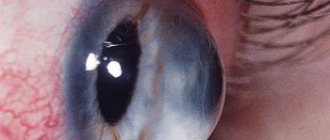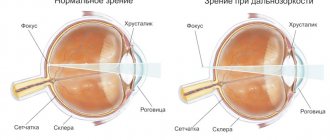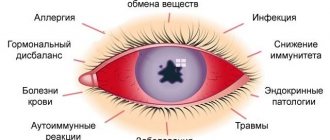Conjunctivitis is an inflammation of the thin mucous membrane covering the eyeball and the adjacent surfaces of the eyelids. This connective membrane, or conjunctiva, is normally transparent and colorless; it serves to moisten the cornea with a liquid mucous secretion, which is produced by the own glands of the conjunctiva in addition to the secretion of the main lacrimal glands. The conjunctiva receives nutrition from blood circulation in a network of small, almost invisible vessels, closely connected with the blood supply system of the eyelids. Inflammatory processes in this important structural element of the visual system manifest themselves as symptoms common to all conjunctivitis, due to the anatomical structure of the conjunctiva (redness of the eyes due to swelling and blood filling of the vascular network, characteristic turbidity, discomfort in the eye, increased lacrimation), and specific, due to cause and source of inflammation (presence/absence of purulent exudate, itching or pain, photophobia or swelling of the eyelids, etc.). Finally, some forms of conjunctivitis, for example, chlamydial in the early stages, can be practically asymptomatic for a long time.
Fig. 1 Preparations in the form of eye drops and ointments are the main method of treating conjunctivitis
The nature and pathogenic properties of the damaging factor, as well as the type of conjunctivitis (acute or chronic), determine the therapeutic approach. Thus, along with the elimination of general symptoms (anti-inflammatory, desensitizing, and, if indicated, moisturizing drugs) for conjunctivitis, etiopathogenetic measures should always be taken to eliminate the causes of inflammation. Therefore, the primary task of an ophthalmologist is usually to study the medical history, differentiate between various suspected types of conjunctivitis, and clarify diagnostics (for example, bacterial culture or serological testing to accurately identify the causative agent of the infectious-inflammatory process).
Thus, the clinical picture, the most likely dynamics of development, and the response therapeutic strategy depend on the etiological causes of conjunctivitis. In addition, the etiological criterion underlies the generally accepted typological classification of conjunctivitis. So, below are the most common types of conjunctivitis and the most effective means of treating it today. It should be emphasized that this information is provided for informational purposes only and can in no way be used as recommendations for self-medication.
Fig. 2 Antibacterial drops - a mandatory component of treatment
Bacterial type of conjunctivitis
Bacterial conjunctivitis most often occurs in childhood. This is due to the fact that babies are not able to fully control their movements, so they do not always rub their eyes and eyelids with their hands. As a result, bacteria enter the eye mucosa by contact, which, when multiplied, lead to the development of the disease. For bacterial conjunctivitis, it is very important to be careful when choosing eye drops, since cheap drugs, for example, Albucid, can lead to unwanted side effects associated with its high aggressiveness. For a bacterial eye infection, it is much better to use drops called Tobrex, which contains a broad-spectrum antibiotic. This drug not only has a lot of good patient reviews, it is also recommended by ophthalmologists for the treatment of bacterial conjunctivitis, including in childhood.
What medications can be used for viral conjunctivitis?
If the patient has been diagnosed with a viral form of conjunctivitis, the ophthalmologist will recommend drops that contain components that suppress the replication of the virus. Also, these drugs can have a regenerating and calming effect on the conjunctiva. The doctor will decide which of them to instill into the eyes. Self-selection of drops is unacceptable. For adenoviral conjunctivitis, certain drugs are prescribed, for enteroviral conjunctivitis, others are prescribed. The following eye drops have proven to be highly effective:
- "Ophthalmoferon". Popular drops with antiviral, antihistamine, immunomodulatory effects. The drug has many advantages. It can be used to treat conjunctivitis in adults and children. The main active components of Oftalmoferon are interferon, aimed at suppressing the virus, and diphenhydramine, which effectively relieves itching and burning. The duration of treatment is usually no more than a week. The ophthalmologist decides how much to drip “Ophthalmoferon” individually in each specific case. During the first days, it is recommended to instill the drug into the eyes no more than 6 times. In subsequent ones - no more than three. The drops have no contraindications for use. The exception is individual intolerance to the components of the drug.
- "Aktipol". These eye drops contain para-aminobenzoic acid, which is an inducer of endogenous interferon. It increases the amount of proteins released by the body's cells in response to damage from viruses. Effectively eliminates "Actipol" and swelling of the eyelids - one of the most common symptoms of conjunctivitis. The drug has virtually no contraindications and can be used to treat children, but only with the consent of a doctor. Actipol is instilled into the eyes, 1-2 drops 6-8 times a day. The duration of treatment is determined by the ophthalmologist after examining the patient. The drug is recommended to be used after clinical recovery - 3 times a day for 5 days.
- "Florenal". Another effective eye drops that ophthalmologists prescribe to patients with a viral form of conjunctivitis. The drug has a pronounced antiviral effect and is able to suppress the proliferation of viral cells in the tissues of the visual organs. Florenal can be used for conjunctivitis caused by the herpes virus. The advantage of the drug is that it has an exclusively local effect and is not absorbed into the bloodstream. Instill Florenal 1-3 times a day, a couple of drops. The duration of treatment is prescribed by the ophthalmologist. In some patients, the drug may cause side effects, such as itching and burning in the eye area. Usually they are short-lived and do not require discontinuation of the drops.
List of essential medications
In addition to information about which drops can eliminate the signs of conjunctivitis and help cope with eye fatigue, several other remedies that require a more detailed discussion should be indicated:
- Gludantan is a powder that must be dissolved before use.
- Poludan is a remedy to combat the symptoms of conjunctivitis. The package does not include a dropper, so you need to buy an additional pipette.
- Oftadet is used not only in cases of acute conjunctivitis, but also for gonorrheal lesions in children.
- Sofradex is an ointment that eliminates inflammation and can be used for a large number of ophthalmic problems.
- Florexan is used mainly for mild conjunctivitis. In addition, this solution is excellent for disinfecting contact lenses.
- Vigamox is a very effective drug that is prescribed to treat corneal ulcers. It is mainly suitable for elderly patients.
- Indocollyr is often prescribed for infectious diseases, including in the postoperative period.
- Rohto normalizes not only the eyes, but the entire body. This medicine is not used for treatment, but for the prevention of inflammatory processes.
You should also note medications that contain cortisone or chloramphenicol. When using such drops, pain and burning in the eyes may occur during instillation.
All of the drugs listed are quite effective, but only an experienced doctor can choose the one that is needed in a particular situation. In an emergency situation, that is, when it is not possible to visit a doctor in the near future, and conjunctivitis progresses, one of the medications can be used. In the future, at the first opportunity, you still need to consult a doctor to clarify the correct choice of drug. In addition, different drugs are used for adult patients and for children, so you need to be careful not to harm the child. For example, drugs for adults are usually more aggressive and cause pain and lacrimation; they are contraindicated for children. Sometimes the doctor prescribes a course of antibiotics to treat purulent conjunctivitis, but all this is individual and determined by the type of disease.
Eye drops and ointments for allergic conjunctivitis
In case of allergic conjunctivitis, it is necessary, first of all, to eliminate or minimize contact with the allergen. To relieve symptoms, antihistamine H1-blockers are prescribed to suppress the allergic reaction:
- drops Allergodil, Opatanol, Cromohexal, Lecrolin, Ketotifen, etc.;
- decongestant and vasoconstrictor drops (Vizin, Visomitin, Oksial);
- eye ointments, incl. hormonal (Hydrocortisone, Dexamethasone);
Tablets of systemic antihistamines (for example, Tavegil, Suprastin, Loratadine and their analogues) may also be prescribed.
Opatanol
Drops for conjunctivitis "Opatanol" produced in Belgium are used for the allergic nature of the disease. "Opatanol" is intended for adults and children over 3 years old. These drops are also suitable for pregnant women. To treat allergic conjunctivitis, you need to use these eye drops 2 times a day, but do not forget to shake the bottle before each drop. Opatanol is well tolerated and has almost no side effects. The active substance of the drug is olopatadine hydrochloride, which triggers anti-allergenic mechanisms.
Opatanol
Alkon, Switzerland
Opatanol - decongestant and antiallergic eye drops for use in ophthalmology.
from 352
478
- Like
- Write a review
How to treat conjunctivitis
Treatment of conjunctivitis should be aimed at eliminating the causes that caused it. And the causes of the disease can be determined by an ophthalmologist.
For bacterial
form, you need to wash your eyes with saline solution, plus the doctor prescribes drops for conjunctivitis.
Viral
conjunctivitis is usually not treated (like colds), since there are no special antiviral drugs for this disease - the person recovers on his own.
If necessary, treatment is reduced to symptomatic therapy to reduce negative symptoms (artificial tears, cool compresses). Allergic
conjunctivitis involves eliminating the causes of allergies.
Basic rules of hygiene when treating conjunctivitis:
- If you wear contact lenses, remove them until you recover;
- do not touch your eyes with your hands;
- wash your hands frequently and thoroughly;
- exclude close contact with others;
- during illness you should have your own soap and towel, change pillowcases and bed linen as often as possible;
- with conjunctivitis, women need to give up eye cosmetics;
- Ventilate the room you are in more often.
Drops for pregnant women
Aktipol eye drops
A special medical composition that belongs to the group of drugs that are used to combat eye and ear diseases of inflammatory and infectious types. The drops are a transparent liquid that has no foreign odor or color. Aminobenzoic acid is used as the main active agent - this agent is widely used in the field of ophthalmology. The substance has a very wide spectrum of action. In particular, the composition is distinguished by local anesthesia - it quickly numbs the eyes. Corneal tissue begins to regenerate much faster. Such drops are capable of fighting a variety of types of viruses, and they also increase local immunity.
More: Top 10 best teething products
It is not at all necessary to bury them in case of illness; they also act as a prophylactic agent. Such drops are used if discomfort or redness of the eyes occurs if a person wears contact lenses. The product easily copes with viral conjunctivitis. If follicles form on the mucous membrane. The composition also fights well against pain, discharge and drying out of the mucous membrane. Drops cope well with ophthalmological diseases, the course of which is accompanied by inflammatory processes. The only contraindication to the use of this composition is individual intolerance to individual components.
Advantages:
- Harmless substance;
- Reliably protects against viruses and inflammation;
- Thoroughly heals even serious wounds;
- With the help of drops you can develop local immunity.
Flaws:
- The shelf life of the opened package is not too long;
- Individual intolerance to individual constituent elements occurs.
Aktipol eye drops
Oftalmoferon
It is used in medical practice to cope with eye diseases of various nature, both viral and allergic. The product is characterized by active antiviral and antibacterial effects. The composition contains interferon, which stimulates the production of local immunity. This medicine has a local anesthetic effect. Due to this, the burning sensation is relieved within half an hour, the same thing happens with the redness of the mucous membrane. Drops can be used as a therapeutic or prophylactic composition. They allow you to prevent the occurrence of viral conjunctivitis, as well as get rid of it if a person suffers from allergic reactions.
The solution is a colorless and completely transparent liquid in which no sediment or foreign inclusions are observed. It comes in small polymer bottles, the volume of which is 5 or 10 ml, the lid is made in the form of a dropper dispenser for ease of use. The active agent is recombinant interferon, a protein that the human body can produce independently. Diphenhydramine hydrochloride can also help cope with diseases. This remedy can combat eye diseases not only for pregnant women, but also for nursing mothers and children over the age of one year. The drug is prescribed exclusively by the attending physician, although the composition is sold without a prescription. Instill 4-6 times a day, two drops into each eye. When positive dynamics are noticeable, the number of instillations is reduced to 2-3 per day. The duration of treatment can reach one and a half months.
Advantages:
- It can even be used with other medications that enhance the effects of the drug;
- Allowed for use by pregnant, lactating women and small children;
- Allows you to cope well with redness and inflammatory processes.
Flaws:
- Quite expensive;
- Short shelf life after opening the package.
Oftalmoferon
Taufon
Effectively copes with many inflammatory eye diseases. They can be used both before and after surgery. With the help of this remedy you can prevent infection, as well as quickly get rid of pain after surgery. The product is either completely transparent or has a slight yellowish tint. The drops do not contain any foreign matter, flakes, etc. Diclofenac sodium is used as the main active agent here. The composition also contains polyethoxylated castor oil, trometamol, purified water, benzalkonium chloride, mannitol and some other agents. The drops have an anti-inflammatory and analgesic effect.
The active substances bind cyclooxygenase, after which the development of pathogenic and viral microorganisms slows down. After just a couple of days of regular use, swelling decreases, vision improves, and the blurred vision goes away. The substance is most active in the first half hour after instillation. The substance does not enter the bloodstream and, accordingly, has no effect on internal organs. Drops can be used as a prophylactic if a person suffers from increased photosensitivity.
Advantages:
- Reasonable cost;
- Quickly and reliably copes with pain and swelling;
- Bacteria do not become accustomed to this product;
- Quite a long lasting positive effect.
Flaws:
- Immediately after instillation, a slight burning sensation may be felt.
Taufon
How to put eye drops correctly?
contact lenses, it is better to remove them. To make instillation more convenient, you should pull back the lower eyelid with your finger, roll your eyes and drop the required amount of the drug into the space that forms between the pulled eyelid and the eyeball. After this, it is recommended to close your eyes for a few minutes. This will help enhance the effectiveness of the drops.
Some medications that are used to treat conjunctivitis may have a negative reaction after instillation. This is explained by the fact that due to the inflammatory process the mucous membrane becomes more sensitive. For this reason, she reacts sharply to the active components of the drug. Sometimes side effects may occur, for example: stinging, burning, pain in the eyes. You just have to endure these unpleasant sensations. In this case, there are no other means of dealing with discomfort. Replacing a drug, even with the permission of an ophthalmologist, does not always guarantee the absence of unpleasant sensations during instillation. Usually this is not due to the quality of the drops, but to the sensitivity of the mucous membrane of the eye.
How to treat conjunctivitis.
August 17, 2021
7531
5
1
Content
- Symptoms of conjunctivitis
- Types of conjunctivitis
- How to treat conjunctivitis
- The most effective drops for conjunctivitis
- Ciprofloxacin-Optic
- Montevisin
- Levomycetin
- Opatanol
- Oftalmoferon
- Aktipol
- Drops for conjunctivitis for children
- Tsiprolet
- Diclofenac
- Vitabact
- Visine Classic
Conjunctivitis
is a common eye disease in which the mucous membrane of the eyeball, the inside of the eyelids and the sclera (the “white” of the eye) become inflamed.
Conjunctivitis usually does not pose a health risk and can go away on its own without treatment, but there are forms of conjunctivitis that cause complications or are contagious.
Definition and reasons
Inflammation of the connective membrane of the eye is called conjunctivitis and is considered one of the most common ophthalmological disorders. The conjunctiva is a protective barrier that protects the eyeball from the negative effects of the environment. In addition, the eye cover performs a secretory function necessary for the natural hydration of the cornea. When inflammation occurs, the transparent, smooth conjunctiva (normally) becomes cloudy and bloody. Other symptoms also appear, creating a clinical picture that often contributes to vision deterioration.
Conjunctivitis of the eyes in adults occurs due to the same reasons as in children.
For the most part, the etiology of the disease is interpreted as direct pathogens:
- bacteria (staphylococci, gonococci, etc.);
- viruses (herpes, ARVI, etc.);
- fungi;
- chlamydia;
- allergens.
However, there are also indirect causes that can cause conjunctivitis of the eyes in adults. These include:
- existing or previously suffered diseases that negatively affected the immune system;
- concomitant ophthalmological pathologies of various origins (viral, refractive);
- failure to comply with hygiene rules when caring for the eyes, for example, when using contact lenses;
- injury to the organs of vision;
- venereal diseases;
- use of low quality cosmetics.
Eye conjunctivitis in adults usually manifests itself in an acute form, when the signs of the disease are noticeably disturbing and disturbing. However, ignoring this condition or uncontrolled self-medication does not lead to recovery, but contributes to the transition of the pathology to a chronic form, requiring long-term systemic therapy.
Is it possible to choose eye drops yourself?
You cannot choose eye drops yourself. Their selection should only be carried out by an ophthalmologist. After collecting information about the patient’s complaints and general health, for example, the presence of chronic diseases, the doctor will be able to prescribe a drug to treat conjunctivitis. It becomes clear what to put in the patient’s eyes, but not everyone follows the ophthalmologist’s recommendations.
It often happens that a person visits a pharmacy, consults with a pharmacist, and chooses other eye drops. This is often due to the lower cost of the drug. Some patients ask the pharmacist which similar products have the same active ingredient and purchase a similar drug. This should not be done, since the main substance is usually not the only one included in the composition of the drops.
Groups of drops with antibiotics
These drugs are divided into three groups depending on the pronounced effect.
Aminoglycosides. Active substances penetrate the membranes of pathogen cells and suppress protein synthesis in them. The active substances are localized in the cornea, vitreous body and fluid of the anterior chamber of the eye. In total, there are about 100 drugs in this group. Fluoroquinolones. A relatively new category of potent antibiotics against inflammatory and infectious diseases. The great advantage of such drugs is their rapid effect. This is because fluoroquinolones immediately enter the bloodstream. However, for all their positive properties, they also have many side reactions and contraindications, so such drops are used with caution. Levomycetins. This group includes drugs based on chloramphenicol, which disrupt protein synthesis in ribosomes at the DNA and RNA level, thereby providing a bacteriostatic effect. These are inexpensive medications with a minimum of side effects, approved even for pregnant women and children. But they are not effective for all types of conjunctivitis.










